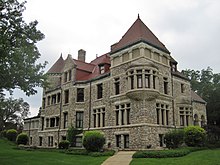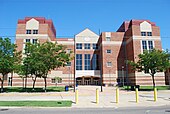
South Bend is a city in and the county seat of St. Joseph County, Indiana, United States, on the St. Joseph River near its southernmost bend, from which it derives its name. At the 2020 census, the city had a total of 103,453 residents and is the fourth-largest city in Indiana. Located just south of the border with Michigan, South Bend anchors the Michiana region and is 72 miles (116 km) east of downtown Chicago. The metropolitan area had a population of 324,501 in 2020, while its combined statistical area had 812,199.

WSJV is a television station licensed to Elkhart, Indiana, United States, serving the South Bend area as an affiliate of the digital multicast network Heroes & Icons. It is owned by Gray Media alongside NBC affiliate WNDU-TV. The two stations share studios on the University of Notre Dame campus along State Road 933 on South Bend's north side; WSJV's transmitter is co-located within the WSBT-TV site on Ironwood Road in South Bend.
WFIU is a public radio station broadcasting from Indiana University Bloomington (IUB) in Bloomington, Indiana, United States. The station is a member station of NPR, Public Radio International and American Public Media. Together with IUB-owned television station WTIU, it is known as Indiana Public Media. Studios are located in the Radio-Television Building on the IUB campus, and the transmitter is located at a site on South Sare Road in Bloomington. Seven translators broadcast WFIU and its second HD Radio subchannel, primarily in areas outside of the main transmitter's coverage area, including Terre Haute and Kokomo.
WYCC was a public television station in Chicago, Illinois, United States. It was last owned by not-for-profit broadcasting entity Window to the World Communications, Inc., alongside PBS member station WTTW and classical music radio station WFMT. WYCC's operations were housed with WTTW and WFMT in the Renée Crown Public Media Center, located at 5400 North Saint Louis Avenue in the city's North Park neighborhood; WYCC and WTTW shared transmitter facilities atop the Willis Tower on South Wacker Drive in the Chicago Loop. WYCC previously maintained studios at Kennedy–King College on South Union Avenue and Halsted Parkway in the Englewood neighborhood.

KUNM is a public radio station broadcasting on FM 89.9 MHz from high atop Sandia Crest, with broadcasts originating from the third floor of Oñate Hall, on the campus of the University of New Mexico (UNM) in Albuquerque, New Mexico.

WBAA and WBAA-FM (101.3 FM) are jointly operated non-commercial educational radio stations licensed to West Lafayette, Indiana, United States, both serving the Lafayette metro area and the Indianapolis area with public radio formats. The stations were founded by Purdue University, but in 2022, 100 years after WBAA's start, ownership was transferred to Metropolitan Indianapolis Public Media, Inc. (MIPM), which also owns WFYI radio and television in Indianapolis. Both stations originate from studios in the Edward C. Elliott Hall of Music on the Purdue campus, with transmitter sites south of Lafayette at the Throckmorton Purdue Agricultural Center.
KNKL is a contemporary Christian music radio station in Tremonton, Utah, United States. The station is owned and operated by the Educational Media Foundation (EMF) and broadcasts EMF's K-Love programming.
KBAQ is a public radio station in Phoenix, Arizona, United States, playing classical music. It is co-owned by the Maricopa County Community College District (MCCCD) and Arizona State University (ASU). The studios are located at MCCCD's Rio Salado College in Tempe, alongside MCCCD-owned KJZZ, while the station broadcasts from a transmitter on South Mountain. In addition to its FM signal, it is broadcast as an audio subchannel (8.5) of ASU-owned KAET television across central, northern, and southwestern Arizona.
KXJZ is a non-commercial, listener-supported public radio station in Sacramento, California. It is owned by Sacramento State University and has studios on the campus at 7055 Folsom Boulevard. KXJZ's sister station is classical music-formatted KXPR 88.9 FM. The two stations are known as CapRadio.

WGCS is an adult album alternative-formatted broadcast radio station. The station is licensed to Goshen, Indiana, and serves Goshen, Elkhart, and South Bend in Indiana. WGCS is owned by Goshen College and operated under their Goshen College Broadcasting Corporation licensee.
WSBT is a commercial radio station in South Bend, Indiana, which airs a sports radio format. It is owned by Mid-West Family Broadcasting, with studios and offices on East Monroe Street in downtown South Bend.
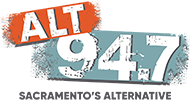
KKDO is a commercial radio station licensed to Fair Oaks, California, and serving the Sacramento metropolitan area radio market. The station is branded "Alt 94-7" and it programs an alternative rock radio format. The Audacy, Inc. outlet has its transmitter off Rosebud Lane in Citrus Heights. Its studios are located in North Highlands.

KRVM-FM (91.9 MHz) is a community radio station in Eugene, Oregon, United States. KRVM's primary programming is available via online streaming, with listener-supporters located around the world. The station license and studio facility are owned by Eugene School District 4J, but the school district provides no direct funding to the station; all funding comes from listener supporters, business underwriters, and the Corporation For Public Broadcasting. The main studio is located at Sheldon High School, with a satellite studio at Spencer Butte Middle School.
Sarkes Tarzian was an Ottoman-born American engineer, inventor, and broadcaster. He was ethnic Armenian born in the Ottoman Empire. He and his family immigrated to Philadelphia, Pennsylvania, United States in 1907, following their persecution by Ottoman Turks. "His father escaped to America from the Turkish massacres of Armenians, and got a job as a weaver." In 1918, he was the top high school graduate in the city of Philadelphia, earning him a four-year, all-expenses-paid college scholarship to the University of Pennsylvania where he received an undergraduate degree in 1924 and a graduate degree in 1927. Tarzian worked for the Atwater Kent company and then for RCA in Bloomington, Indiana.
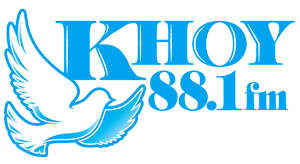
KHOY is an easy listening-formatted radio station in Laredo, Texas, United States targeting a Catholic audience. It is owned by Laredo Catholic Communications, Inc., itself under the Diocese of Laredo, with studios on Corpus Christi Street in Laredo.
KNAU is a radio station broadcasting a classical music and news/talk and information format. Licensed to Flagstaff, Arizona, United States, KNAU and its sister stations serve Northern Arizona. The station is currently owned by Northern Arizona University (NAU) and features programming from National Public Radio, Public Radio International, and American Public Media, among other content providers. NAU also owns KPUB, a station devoted to talk programming, and student-run low-power station KLJX-LP. KNAU's programming is heard on KNAA in Show Low and on five translators in northern Arizona, as well as online.
WVUB is a public radio station licensed to Vincennes, Indiana, United States. The station is owned by Vincennes University (VU), operating from studios in Davis Hall on the university's main campus. Its transmitter is located approximately 2 miles (3.2 km) southeast of Vincennes, near Vincennes Lincoln High School.
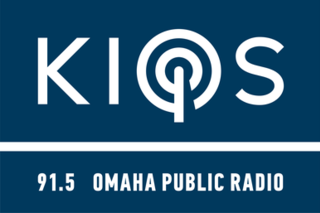
KIOS-FM is a non-commercial, listener-supported public radio station in Omaha, Nebraska. It is owned and operated by Omaha Public Schools (OPS), airing programming from National Public Radio (NPR) and other public radio producers. KIOS-FM has an annual budget of $1.2 million and employs 15 people. Studios and offices are in the OPS complex on Burt Street, northwest of Downtown Omaha.
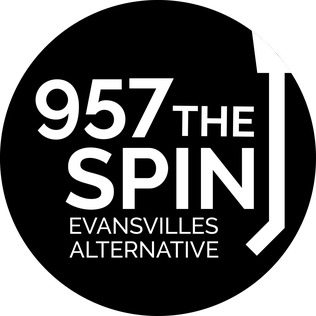
WSWI is a non-commercial educational radio station licensed to Evansville, Indiana, United States, carrying an alternative rock format known as "95.7 The Spin". Owned by the Board of Trustees of the University of Southern Indiana (USI), the campus radio station has studios and a transmitter site located on the USI campus in Evansville. WSWI operates during the daytime hours only, thus in addition to a standard analog transmission, the station's format is broadcast continuously via a simulcast over the HD2 digital subchannel of WPSR and a relay over low-power analog translator W239CI, along with being available online.

The South Bend City Cemetery is a historic cemetery in South Bend, Indiana.
